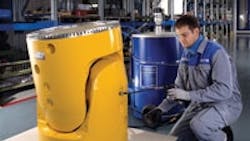Tight budgets mean manufacturers might want to explore less capital-intensive ways to improve machine maintenance within their operations. Technology and new equipment investments have been some of the more traditional ways manufacturers have upgraded their maintenance. But manufacturers have other options that aren't as costly, including data analysis, project-flow adjustments and retooling machines rather than buying new.
Industrial automation provider Schneider Electric has helped customers in the auto industry save money on new equipment through retrofits and new control systems, says John Boville, market segment manager of the company's industry business. "Competitive forces and reduced demand for manufacturing capacity are driving the need to reuse and reconfigure equipment rather than buy new machines and build greenfield plants," he says.
Since 2005, India-based steel maker Tata Steel has reduced maintenance costs by using a method based on Eliyahu Goldratt's Theory of Constraints called Critical Chain Project Management (CCPM). Machines in a steelmaking environment can take a beating, especially at Tata's operations in Jamshedpur, India, where the company's hot-strip mill consumes approximately 400 megawatts of power, enough for a small metropolitan area, notes Sudipto Sarkaread, head of technical services at the hot strip mill.
Using CCPM, the company was able to cut maintenance shutdown periods to no more than 4.5 days from seven and save approximately $30 million to $45 million in maintenance costs in the first year. The program works based on the theory that workers at upstream operations during a shutdown would use all the estimated time to complete a task to avoid creating unreasonable expectations for future projects. This would create delays for downstream projects. On the other hand, if the maintenance worker finished early, the next project wouldn't necessarily reap the benefits because the technician at the downstream mill is already working on multiple tasks, Sarkaread explains.
The goal is to complete the entire project on time -- not just individual tasks, Sarkaread says. It also encourages teamwork. "The vice president of Tata Steel made a comment once, and he said, 'What happens when you have a formal buffer and it is visible to everybody, everybody realizes that he has a share in that buffer," Sarkaread recalls. "If somebody is consuming the buffer because he is stuck, then everyone wants to help him -- not because they want to do social service, but because they want to protect the buffer for themselves.'"
See Also
About the Author
Jonathan Katz
Former Managing Editor
Former Managing Editor Jon Katz covered leadership and strategy, tackling subjects such as lean manufacturing leadership, strategy development and deployment, corporate culture, corporate social responsibility, and growth strategies. As well, he provided news and analysis of successful companies in the chemical and energy industries, including oil and gas, renewable and alternative.
Jon worked as an intern for IndustryWeek before serving as a reporter for The Morning Journal and then as an associate editor for Penton Media’s Supply Chain Technology News.
Jon received his bachelor’s degree in Journalism from Kent State University and is a die-hard Cleveland sports fan.
